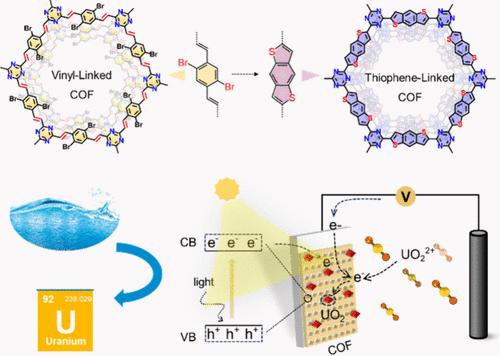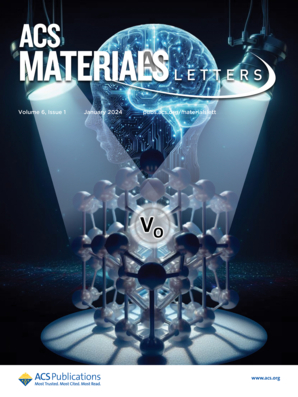硫代-嵌合-辅助合成全共轭苯并噻吩连接共价有机框架,实现强增强型光电催化铀萃取
IF 8.7
1区 化学
Q1 MATERIALS SCIENCE, MULTIDISCIPLINARY
引用次数: 0
摘要
线性聚噻吩材料因其可调的电子结构和优异的光电活性,在光催化和电催化领域展现出巨大的潜力。将噻吩结构从一维线性聚合物扩展到二维共价有机框架(2D COF)有望进一步提高光吸收/转换效率。在这里,我们展示了通过硫醇环化法对溴功能化、乙烯基连接的二维 COF(即 v-2DCOF-Br)进行后修饰,合成全共轭二维苯并噻吩连接 COF(2DCOF-S)的过程。高π共轭在很大程度上将光吸收边沿从 480 纳米扩展到 800 纳米。此外,我们还在苯并噻吩和三嗪核心之间获得了一种内在的供体-受体(D-A)结构,这大大提高了光生电子和空穴的分离能力。最后,我们证明了 2DCOF-S 在光电催化铀萃取中的优异性能,在 2 小时内铀的最大饱和吸附容量高达 643 mg g-1,优于大多数基于 COF 的萃取材料。本文章由计算机程序翻译,如有差异,请以英文原文为准。

Thiolation-Annulation-Assisted Synthesis of Fully Conjugated Benzothiophene-Linked Covalent Organic Framework toward Strongly Enhanced Photoelectrocatalytic Uranium Extraction
Linear polythiophene materials have exhibited great potential in photo- and electrocatalysis due to their tunable electronic structures and excellent photoelectroactivity. Expanding the thiophene structure from a one-dimensional linear polymer to a two-dimensional covalent organic framework (2D COF) is expected to further enhance the light absorption/conversion efficiency. Here we show the synthesis of a fully conjugated 2D benzothiophene-linked COF (2DCOF-S) by the postmodification of a bromine-functionalized, vinyl-linked 2D COF (i.e., v-2DCOF-Br) through thiolation annulation. The high π conjugation largely extended the light absorption edge from 480 to 800 nm. Furthermore, an intrinsic donor–acceptor (D-A) structure between the benzothiophene and triazine cores was obtained, which significantly improves the separation capability of photogenerated electrons and holes. Finally, we demonstrate that the 2DCOF-S exhibited excellent performance in photoelectrocatalytic uranium extraction, in which the maximum saturated adsorption capacity of uranium is up to 643 mg g–1 within 2 h, which is superior to most COF-based extraction materials.
求助全文
通过发布文献求助,成功后即可免费获取论文全文。
去求助
来源期刊

ACS Materials Letters
MATERIALS SCIENCE, MULTIDISCIPLINARY-
CiteScore
14.60
自引率
3.50%
发文量
261
期刊介绍:
ACS Materials Letters is a journal that publishes high-quality and urgent papers at the forefront of fundamental and applied research in the field of materials science. It aims to bridge the gap between materials and other disciplines such as chemistry, engineering, and biology. The journal encourages multidisciplinary and innovative research that addresses global challenges. Papers submitted to ACS Materials Letters should clearly demonstrate the need for rapid disclosure of key results. The journal is interested in various areas including the design, synthesis, characterization, and evaluation of emerging materials, understanding the relationships between structure, property, and performance, as well as developing materials for applications in energy, environment, biomedical, electronics, and catalysis. The journal has a 2-year impact factor of 11.4 and is dedicated to publishing transformative materials research with fast processing times. The editors and staff of ACS Materials Letters actively participate in major scientific conferences and engage closely with readers and authors. The journal also maintains an active presence on social media to provide authors with greater visibility.
 求助内容:
求助内容: 应助结果提醒方式:
应助结果提醒方式:


